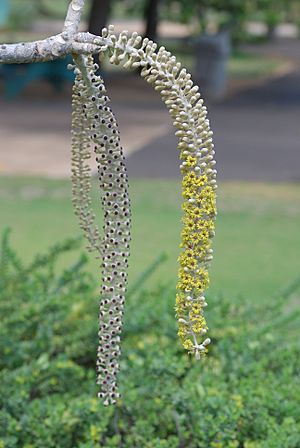False 'ohe facts for kids
Quick facts for kids False 'ohe |
|
|---|---|
 |
|
| Polyscias racemosa growing in Maui Nui Botanical Gardens, Maui, Hawaii. | |
| Conservation status | |
| Scientific classification | |
| Genus: |
Polyscias
|
| Species: |
racemosa
|
| Synonyms | |
|
|
The Polyscias racemosa, also known as the false 'ohe, is a special kind of flowering plant. It belongs to the family called Araliaceae. For a long time, this plant was thought to be the only species in its own group, called Munroidendron. But scientists have recently changed its classification. Now, Munroidendron is no longer used.
The false 'ohe is a native plant found only on the Hawaiian island of Kauai. It is very rare in the wild. Sadly, some of its original habitat was replaced by sugar cane farms. People once thought this plant was extinct, meaning it had completely disappeared. But luckily, it was found again a few years before 1967!
Scientists have used DNA studies to learn more about plants. These studies showed that the false 'ohe is most closely related to another plant called Polyscias sandwicensis. Because of this, both plants are now part of the Polyscias group. They are among 21 species now placed in a subgroup called Polyscias subgenus Tetraplasandra. You can also find Polyscias racemosa growing in gardens in Hawaii. People have studied how to grow it best.
Contents
What Does the False 'Ohe Look Like?
The Polyscias racemosa is a small tree. It can grow up to 25 feet (7.6 meters) tall. It has a straight trunk and branches that spread out. Its bark is smooth and grey.
Like many plants in the Polyscias group, it doesn't have many branches. Its stems are thick. The leaves are large and made up of many smaller leaflets. Each leaf can be about 12 inches (30 cm) long. The oval leaflets are over 3 inches (7.6 cm) long.
These trees drop most of their leaves during the dry summer season. This happens when they are blooming. Their small, pale yellow flowers hang down in long strands, like ropes. A single flower cluster can have up to 250 flowers!
Where Does the False 'Ohe Live?
The Polyscias racemosa grows in special kinds of forests in Hawaii. These are called coastal mesic and mixed mesic forests. You can find it at elevations from 120 to 400 meters (about 390 to 1,300 feet). It likes to grow on exposed cliffs and ridges.
Other plants that grow near the false 'ohe include papala kepau (Pisonia umbellifera), ʻāwikiwiki (Canavalia galeata), ʻilima (Sida fallax), ʻōlulu (Brighamia insignis), alaheʻe (Psydrax odorata), kōpiko (Psychotria spp.), olopua (Nestegis sandwicensis), ʻahakea (Bobea timonioides), hala pepe (Pleomele aurea), and ʻālaʻa (Pouteria sandwicensis).
This tree grows naturally in only three places on Kauaʻi. These spots are Nounou Mountain, the cliffs of the Nā Pali Coast, and Haʻupu Ridge near Nāwiliwili Bay.
The Story of the False 'Ohe's Name
The Polyscias racemosa was first written about by scientists in 1917. A scientist named Charles Noyes Forbes described it and gave it the name Tetraplasandra racemosa.
Later, in 1952, another scientist named Earl Edward Sherff thought this plant was very different from others in the Tetraplasandra group. So, he created a brand new group, or genus, just for it. He called it Munroidendron. This new name honored George Campbell Munro (1866-1963). Munro was a pioneer who studied birds, plants, and gardening in Hawaii. He was also a plant collector. Dendron is a Greek word that means "tree." It seems Munro was the first person to collect and see this plant that was named after him.
For a while, there was some debate among scientists about whether Munroidendron should be its own group. But studies using DNA helped clear things up. These studies showed that Polyscias racemosa (which was Munroidendron) and Polyscias sandwicensis (which was Reynoldsia sandwicensis) are very closely related. They form a special group together. These two species, along with nine others that used to be in Tetraplasandra, are all part of the Hawaiian Polyscias group.
See also
 In Spanish: Munroidendron racemosum para niños
In Spanish: Munroidendron racemosum para niños






